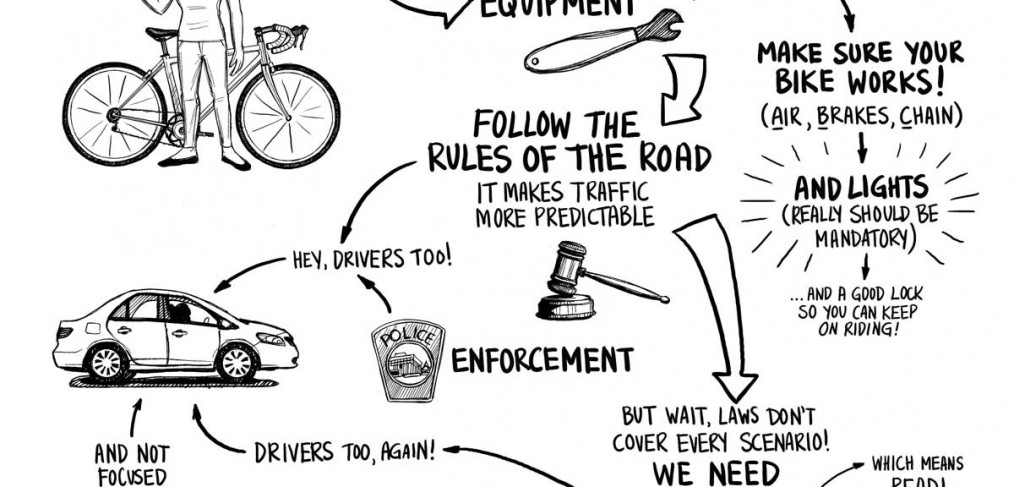
Serious about Safety
Every bike commuter knows is that safety is a complicated issue. They face it every day. However, some safety campaigns focus entirely on helmets. But that means there’s been a crash. What if it could have been prevented? Wouldn’t that be safer?
There’s many points along the way where an individual, a community, and a city, can prevent more tragedies from happening. Helmet or not, when you put a car against a vulnerable road user, you know who the victim will be. Cities need to get real about safety. No excuses.

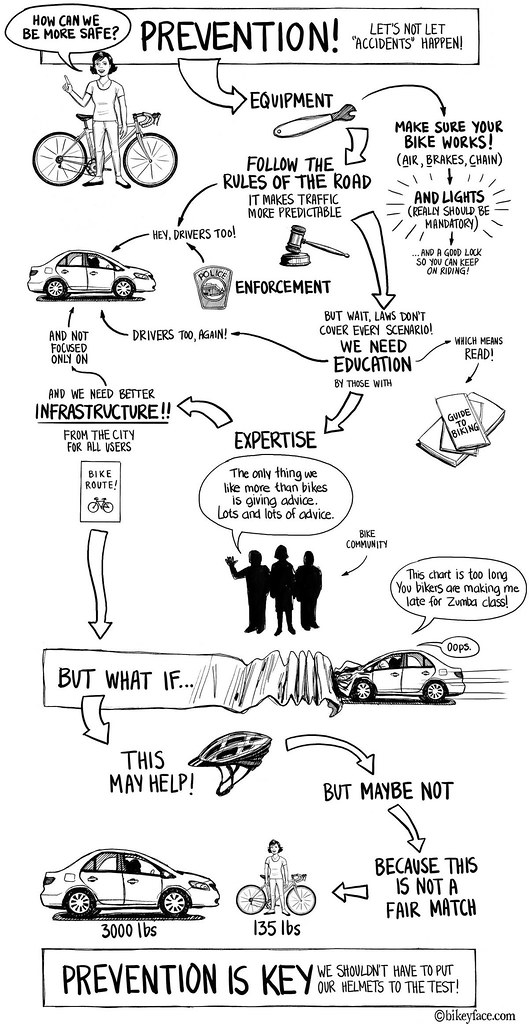
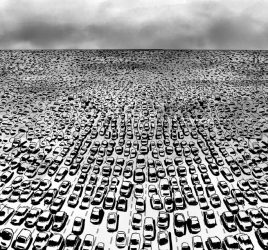
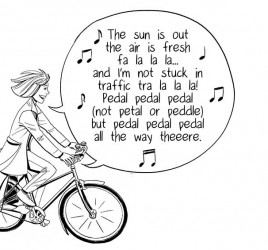
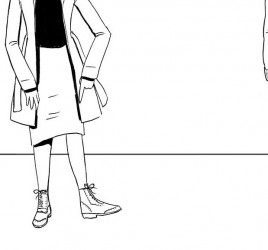
Right on !!!
The notion that motorists and cyclists are in some sort of competition or ‘match’ on the road is false. The basis of traffic law is equal access and laws exist specifically to prevent the bigger vehicle competing against smaller vehicles. This is why rules of priority (sometimes called ‘right of way’) govern every aspect of road use. If everyone acts responsibly and obeys these rules, the road is perfectly safe for cyclists.
It really makes me mad when motorists whine, “Cyclists’ right to the road doesn’t mean much if they’re hit by a truck”. But that’s true for every road user – not just cyclists. Let’s not fall into the trap of repeating their anti-cycling BS.
Bicycle Infrastructure Can Reduce Risk of Cycling Injuries by Half, Canadian Study Finds
The Teschke study (which appears to be ‘Route Infrastructure and the Risk of Injuries to Bicyclists: A Case-Crossover Study’ – published only as a ‘first look’ in the American Journal of Public Health) seems to potentially be yet another example (like the many so-called ‘studies’ done by John Pucher, Ralph Buehler, Anne Lusk, Conor Reynolds and other health and wellness advocates) of how cycling advocacy within the scientific community can create unscientific research that is marred by expectation bias. Dr. Teschke and her associates are involved in public health research and while cycling does have overwhelming health benefits, neither Dr. Teschke or any of the people involved in the study appear to be specialists in transportation injuries or collisions.
In fact, Teschke, Reynolds, Lusk, Harris et al seem to have built much of their careers around research that supports bicycle infrastructure that most respected researchers find to be dangerous. These folks are essentially paint and path advocates masquerading as scientists.
The study appears to be based on self-reporting, which is prone to volunteer or referral bias, and nonrespondent bias. Also, like the infamous Lusk study of 2011, it is based on a route comparison, and these have proven to be very prone to selection bias. I’d like to see the details of this study. Full documentation doesn’t seem to be available at the present time, but I would urge cyclists to be very wary of this study, as 85% of studies done by those who ARE experts in the field of transportation find that cycling infrastructure INCREASES the risk of injury, especially at intersections. Almost every study finds that the increases in injuries at intersections more than counteract any safety gains between road junctions. See the following link for details:
http://ianbrettcooper.blogspot.com/2012/08/bicycle-infrastructure-studies.html
But Ian, isn’t this missing the forest for the trees? Using the unambiguous count-dead-bodies metric, the Dutch have the safest cycling on the planet, and we are far, far from it. All the allegedly reputable safety research done in this country and all the Effective Cycling movement (which has been going on since I was a kid) have amounted to zilch in terms of actual safety improvements and actual increases in ride share. No real change in ride share, cycling here is still less safe than in Northern Europe, and feels much less safe. What the effective cycling promoters have is a safety theory that in practice is incredibly unpopular, and if people won’t do it, then it Does Not Work. I’ve tried selling it to friends and family, and most of them are completely uninterested in trying it. It is not unlike abstinence as a form of birth control; perfect in theory, but not at all popular in practice, and a failure for real people.
In addition, any research done in the US — where the cycling population is tiny and self-selected, or children — is automatically suspect simply because the sample is so weird, and our cycling is so atypical. Or to put this more plainly, if you only study US cyclists, you will not obtain results that apply to the 99% of the population that does not do utility cycling. One might as well plain an economy by studying the household finances of the richest or poorest 1%, or design clothing to fit the thinnest/fattest/tallest/shortest 1%.
And further, the effective-cycling infrastructure bashing is contradicted by actual before-after results in places where infrastructure is installed (good infrastructure, not stupid door lanes). Biking’s been going up in Portland, the total accident rate has remained flat, the per-cyclist rate has fallen. Where infrastructure has been added in NYC (e.g., Prospect Park), accident rates go down.
The Dutch, generally speaking, use a pedestrian mode of cycling – they cycle at walking or jogging speeds. That’s probably why they are safer than anyone else (if indeed they are – Dutch cycling studies are virtually nonexistent.
Effective cycling has had a huge impact on safety, for those who practice it. Unfortunately, the paint and path advocates have had a lot of success instilling fear of such practices. I wish the P&Pers had better success at making their preferred infrastructure safer – something they have failed abjectly to do, when they have tried at all (which is only rarely). They would, it seems, rather spend their time in propaganda efforts, proclaiming safety improvements without evidence and decrying integrated cycling.
Regarding your assertion that before-and-after studies show improvements in safety for roads with bicycle facilities, actually, the one study that did a rigorous before-and-after study on ‘good’ infrastructure (Jensen 2007, Denmark) concluded:
“The safety effects of bicycle tracks in urban areas are an increase of about 10 percent in both crashes and injuries. The safety effects of bicycle lanes in urban areas are an increase of 5 percent in crashes and 15 percent in injuries. Bicyclists’ safety has worsened on roads where bicycle facilities have been implemented.”
Yeah, infrastructure advocates often ‘claim’ that NY facilities result in fewer accidents. Unfortunately, I have not met one advocate who can point me to an available study that supports such assertions. If you can, I’ll be glad to look at it. As for Portland, there is something to be said for the notion of ‘safety in numbers’, but again, reliable studies have yet to be done and all we really have to go on are assertions from parties who have a vested interest in promoting such facilities.
Here’s a breezy presentation of some NY DOT numbers, before and after for Prospect Park West: http://www.xoxosoma.com/ppw/ It got better.
And compare: “Effective cycling has had a huge impact on safety, for those who practice it.”
with “Abstinence is an effective means of birth control, for those who practice it.” The problem is entirely a matter of “for those who practice it” — Effective Cycling is about as popular as abstinence (for all I know it might be less popular).
The reason to focus on the Dutch experience is that we don’t really need “studies” when we see nation-level public health statistics, and ride shares regularly exceeding one-third. The contrast between public health and cycling studies might have a lot to do with the differing conclusions; people who do public health have to deal with people as they are, and not as they wish they were. In practice, the overwhelming majority of people who are exposed to EC reject it (this, from my own experience). You’re not allowed to exclude those failures from your evaluation of EC if you are going to talk about actual safety results and actual ride shares.
Have you had a chance to cycle in the Netherlands?
A lot of this seems to be focused on in-town riding. I am more interested in the rural situation. Not many intersections. Paved shoulders seem like a good idea on busy roads, but there are still a lot of cases of people getting hit while on the shoulder. This is how I end up in the path camp.
Actually, the main reason that the Dutch are safer cycling is because everyone is required to take a cycling educational program (much like our drivers Ed program) and then pass a cycling exam when they are 14. When you have users of the road understanding the way other users may use the road, it increases safety and reduces crashes because people can anticipate & subsequently avoid crashes.
Ian,
We do have cycling studies. But mostly they’re reported in dutch. Would that hinder you? If not, visit http://fietsberaad.nl/ and check the kennisbank (knowledge bank)
And our national statistics agency has numbers of KSI reported for all modes of travel: http://www.cbs.nl/NR/rdonlyres/E846E698-AD1F-4920-AC6D-3568BC06AAC8/0/pb12n026.pdf
more bike deaths in 2011, mainly because more people died in the over-65-ies group in december. How many people in the VS over 65 bike in december? I find the number people killed/ km cycled interesting. Do you know the VS stats? that might help.
It might be not easy to compare the stats between the countries, because the cycling style varies “somewhat” (I have not seen any effective cyclinig in NL in the over 65 group, though they do cycling furtherin the road). And I do execute vehicular cycling in NL (when riding my velomobile it is sometimes useful), but it is considered extremely odd and dangerous by anyone else.
Wondering on your NL experiences in the 6 weeks. Hope to have time to read your blog.
Your comments ignore perceived safety. That is just as important as actual safety. Vehicular cycling may be incredibly safe, but if 99% of the population thinks it’s scary to be riding alongside cars moving at 30+ mph, they’re not going to do it. And more cyclists equalling fewer deaths is a widely accepted trend.
In other words, getting more people cycling results in safer cycling for everyone. If it takes painting rainbows and unicorns on the streets for people to *feel* safe, so be it. So in that regard.. bring on the infrastructure!
“The Dutch, generally speaking, use a pedestrian mode of cycling – they cycle at walking or jogging speeds. That’s probably why they are safer than anyone else (if indeed they are – Dutch cycling studies are virtually nonexistent.”
I’ve seen some tripe, but this takes the biscuit. I’ve seen plenty of fast cyclists on the cyclepaths in Dutch cities, but only when traffic is light. Of course when it’s busy people are going to cycle more slowly, just as people drive must more slowly when the road is congested! Do you really think it’s appropriate to ride at high speeds when there are many people around – young children, the elderly, people with shopping?
And another ‘of course’ – when you have 93% of the population riding at least once per week, not all of them are going to be speed demons. The elderly and young children, for example – the Netherlands isn’t a nation of middle-class white male cyclists aged 18-45, you know.
One thing that struck me in Dutch cities is how far you can cycle without stopping – it’s arranged so well that you hit green light after green light, and you can get from A to B in no time without breaking a sweat.
Surely you can see that people simply don’t enjoy cycling around trucks and cars? The American and British public have been given a choice of vehicular cycling or taking the car – and they have voted with their feet firmly on the gas pedal, not the bike pedal.
“The Dutch, generally speaking, use a pedestrian mode of cycling – they cycle at walking or jogging speeds.”
Incorrect. Ever been there?
They are travelling at the same speed as any average commuting cyclist in north america would travel. ~20-30kph.
The roads are also basically flat, so their avg. speed is probably faster too.
Combine this with infrastructure and respectful drivers too.
I cannot quite see what it is you feel is useful in your quote from (Jensen 2007, Denmark). The numbers are completely meaningless. If cycle infrastructure improves and more people use it I would be extremely surprised if the total number of accidents involving bikes didn’t go up. That’s kind of how percentages work.
Is this accident’s per mile travelled? accidents per 100 users? or just total number of accidents?
Put simply if, say, 1 in 1000 people have an accident in every 100 miles on ‘normal’ roads would better infrastructure make this 2 in 1000 or 0.5 in 1000? The total number of accidents is irrelevant without knowing the relationship to increased number of users AND the distances they travel AND the frequency.
To then use this as some argument against segregation is unfair and does the argument no favours.
The vested interest is with those who believe in ‘assertive’ or ‘effective’ cycling. These tend to be enthusiasts (like myself) who cannot see past their own needs and pay too little heed to the needs of more vulnerable people who will make up the numbers required to drag cycling out of the ghetto of enthusiasts and into the mainstream of modern transport.
This isn’t to say I am not a believer in assertive riding style and the need for access to roads for fast transport and leisure by bike. I just see there is far more untapped potential for cycling to attain a 2nd golden age. And rightly so.
dr2chase:
Please try to ignore the “Cult of the Johns” (Franklin, Forester and to a lesser extent Allen) as they make their dying gasps about “Effective” or “Vehicular” cycling, something they have condmned us to now thanks in large part due to willing traffic engineers for whom their “solutions” cost nothing.
Today the mode share for bicycles in the USA is just under 1% thanks to these aggressive, middle-aged-to-elderly, mostly white, mostly males.
Even in Portland it is now just 6%.
Copenhagen? 35% Groningen? Over 50%!
In order to make cycling mainstream and give it political movement, you need participants of all races, all genders from age 8 to 80. That’s not going to happen under the #VroomVroom crowd’s mentality.
Oh sure, a group ride can be led using these techniques and these are not concepts that a bicycle user should not have in their heads, but once the ride is over, if you think the average individual is going to strap on a mirrored helmet and a neon clown suit, and go for a second ride alone and without any infrastructure or motor-vehicle calming, you over estimate the confidence and desires of the average American who shows an interest in cycling.
For example, the Soeren Jensen paper listed as evidence that bike lanes and cycletracks are bad becasue accidents increased, ends with the point that overall cycling increased, motor vehicle use decreased, which has led to the benefits of more physical activity for the average citizen, less air pollution, less noise and less money going out of the country to buy oil.
(Never mind that Jensen’s major point of the paper was to look at intersection deisgns as shown on page 11).
I find the whole notion bizarre that a group who say they are pro-cycling will then go out of their way to disgrace and dismiss the very kinds of infrastructure that are the only proven ways to get cyclists on the road and vehicles to behave and to respect bikes.
And that much of it comes from a man (Forester) who has not been to the Netherlands since WW2?
http://examinedspoke.wordpress.com/2010/10/26/forty-years-later/
“Then I moved to Holland. My strongest memory was realizing everyday how John Forester had hoodwinked our entire country into dangerous infrastructure that denied the actualization of joy and freedom that I saw each day: children gaining freedom of mobility, moms with 3 kids on a single bike, and seniors having healthy lives.”
http://bikeportland.org/2012/04/25/20-years-later-john-foresters-effective-cycling-to-be-re-published-70941
More links for you all to read as you digest the studies Ian Cooper has listed:
This one has a great mix of pictures from the Netherlands juxtaposed with Franklin & Forester quotes:
http://departmentfortransport.wordpress.com/2012/08/19/franklin-and-forester-quotes-in-a-dutch-context/
Mikael Colville-Andersen’s take:
http://www.copenhagenize.com/2010/07/vehicular-cyclists-secret-sect.html
More blunt:
http://departmentfortransport.wordpress.com/2012/06/28/fuck-you-john-franklin/
http://departmentfortransport.wordpress.com/2012/06/30/frankly-mr-franklin/
http://www.voleospeed.co.uk/search/label/John%20Franklin
(Thankfully, the organizations that understand where cycling is going and can go in the USA have stopped listening to these dinosaurs).
I see the anti-road-cycling cabal are suddenly out in force. I must have touched a nerve somewhere.
right – the goal is to get more people out on bikes – vehicular cycling is a lousy advocacy strategy because you can only convince maybe 1 or 2% of people who are even willing to ride bikes to get around (there was a study done by portland OR back in the 90s – I think of potential riders less than 1% felt that no additional infrastructure was needed) – while it may arguably be “safer” – especially if you reduce speed limits, create laws that place more liability on motorists, and through education, the vast majority of still people want separate infrastructure – even most long-time bike commuters would rather be on a separate path than ride in traffic. the VC people can argue until they’re blue in the face that bike lanes are somehow bad, but this attitude doesn’t increase mode share.
I like bike paths but I don’t think the issue is so clear-cut.
Vehicular cycling might have been more successful if there had been more political will to slow and reduce car traffic.
This political will seems to be materializing now. There are congestion charges in London and Stockholm, and after New Years in Gothenburg too. There are 30 km/h speed limits going up everywhere. Young people are delaying taking drivers’ licenses and people are travelling on high-speed trains and low-fares airlines. Light rail is being built all over the USA.
@erik sandblom:
no – it is clear cut – the vast majority of people won’t ride bikes without separate infrastructure. lowering speed limits and more traffic controls won’t get enough people out on bikes – yeah, it can make things safer (and I’m not arguing against road cycling), but you simply cannot convince enough people to ride on the same road with large motor vehicles – no matter how slow they’re going.
I noticed recently that many of the masters of bicycling have the first name John – Allen, Brooking, Ciccarelli, Forester, LaPlant, Schubert, … probably more I’m forgetting.
I am one of the many cyclists who are grateful that these guys share this planet with us.
I knew I’d forget one.. Franklin.
@Tricia Kovacs – I think you misunderstand the complaint against “the Johns”. The tiny fraction of US residents who are bicycle commuters can indeed be thankful to the Johns for publicizing the safety tactics necessary to effectively cycle in current US conditions. The people who have been ill-served by the Johns are all potential cyclists who are not currently riding, because the Johns have mistaken the local, tactical safety maximum for the global, strategic safety maximum deployed in Northern Europe — better infrastructure (and other things, but mostly infrastructure done right, and that does not mean door lanes). Potential US cyclists outnumber current US cyclists by an order of magnitude and then some. They’ve not been well-served by the Johns at all.
It is also deeply ironic that this tiny, self-selected group of cyclists then complains (incorrectly, in my opinion) of “selection effect” in studies that do not conform to their own atypical experience.
I’ve cycled extensively in the Netherlands – I spent 6 weeks there during my European tour.
Ian, It is clear to anyone but car drivers that the principal cause of automobile accidents are car drivers. Eliminate drivers and the problem goes away. this will happen, probably fairly soon, judging from the success Google and others have had with autonomous automobiles. In the meantime a universal decrease in speed limits by 10 km/hour would slow the slaughter, which extends far beyond auto/cyclist collisions.
Excellent, Ira, thanks!!
Ian Brett Cooper says “I’ve cycled extensively in the Netherlands – I spent 6 weeks there during my European tour.”
According to his website, this took place between 1984 and 1986, so if he hasn’t been back since then he’s not actually used the kind of infrastructure we’re talking about. That was early days for the Dutch cycle paths and very little from that time still remains. Nearly 30 years of development and refinement has happened since then.
It’s a bit like saying you hate Blu-Ray because you tried out a LaserDisc in 1985 and found it too bulky.
Maybe Ian will enlighten us further and tell us when he last cycled in the Netherlands?
My previous doubts about this study have proven justified. I have since found out that the bicycle infrastructure that was used for this study was on Vancouver’s Burrard Bridge. This bridge has no crossing or turning traffic to produce the conflicting traffic movements that make cycle tracks so dangerous. No wonder cycling injuries were reduced by half!
Totally awesome. Will you be making posters (and maybe postcards)? I’d rather hand one of those out than all the all the well-meaning bikey advice!
Well put. You may be right, but it’s hard to win when your opponent weighs 20 times as much as you do!
Again, it’s not a competition. There are no ‘opponents’ on the road and no one ‘wins’ anything. All we’re trying to do is get to work/school etc. We are not in a competition, nor are we at war, and people who use such language are engaging in hyperbole and clouding the real issues.
Motorists do not want to hit us. They are not using their vehicle’s weight against us. They just want to get to work the same as we do. Their major problem is that they believe cyclists don’t belong on ‘their’ roads. This is where the conflict lies. Couching the discussion in terms of a contest based on weight is a mistake – it’s fear-based, because it can only apply to collisions which are very rare indeed, and it does not help to clarify the real issues cyclists face, which are based in misunderstanding.
Motorists do not want to hit us. I agree. But many people drive as if they don’t not want to hit us. Which is why the focus on helmets and not infrastructure is misguided.
” They are not using their vehicle’s weight against us. They just want to get to work the same as we do. Their major problem is that they believe cyclists don’t belong on ‘their’ roads. This is where the conflict lies. ”
Great quote and I completely agree.
Cyclist argues bikes belong on those roads but it becomes ugly when the argument ends with, “well I’m bigger than you so I’m more right”.
There are a lot of videos to the contrary.